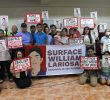By Ardee E. Delola
Today, the newly formed Pilipinong Nagkakaisa para sa Soberanya (P1NAS) is set to hold a protest action against arbitrary foreign expansionism in West Philippine Sea at the Chinese Consular Office in Makati and then march down to the United States Embassy along Roxas Boulevard in Manila. Initiated by former Senator Rene A.V. Saguisag, writer-director Bibeth Orteza, and party-list Bayan Muna, the alliance, while opposing China’s territorial claim and aggressive militarism in the disputed gas-rich sea, also expresses wary that the on-going tension will be used by the United States to justify the return of American military stations in the Philippines.
“If we don’t want Chinese bases in the Spratlys, we certainly don’t want the return of US bases in Luzon, Visayas, and Mindanao,” the group said in a statement.
Bayan Muna earlier accused the United States of merely posturing its defense of the Philippines, as it would not risk its economic relationship with China to which it owes at least US$1.27 trillion and engages in trade worth US$579 billion. The current stance of the Obama administration over the maritime dispute is a strategic mechanism to fortify its imperial interest in the Asia-Pacific region and not a means to defend the territorial right of our country.
This is not the first time that we are called to be critical over US intervention. In 1898, the Americans introduced themselves to the Filipinos as allies that would help liberate the country from more than 300 years of subjugation to Spanish colonial government. The United States defeated Spain in the Battle of Manila Bay, and then assisted the return of Gen. Emilio Aguinaldo on May 19, 1898 from his short exile in Hong Kong. In the presence of his newfound foreign friends, Aguinaldo declared independence from Spain less than a month later, on June 12. One of the signatories to the Act of the Declaration of Independence was said to be an American army officer, which fueled suspicion from Aguinaldo’s then chief adviser Apolinario Mabini. Even the colors of the current Philippine flag, which was first unfurled on that day, was said to have been patterned from the American flag as a sign of profound gratitude.
The ulterior motive of the United States later surfaced when Spain ceded the Philippines to the American government in exchange of $20 million dollars under the 1898 Treaty of Paris, deliberately blindsiding Aguinaldo in the process. This led to the three-year Philippine-American War that saw the carnage of more than 200,000 Filipino fighters and civilians. It was during this period when the United States was rising as a new imperial player that eventually displaced European domination in the world. By the late 19th century, the American economy became heavily dependent on foreign trade. Fearing that it will be closed out in the increasing competition for world market and raw materials, the American government engaged in its own empire-building and the Philippines was its first colonial site in the Pacific.
The United States did not only enforce its political and military authority over the Philippines, it also established what Louis Althusser calls “ideological state apparatuses” like education, government, media and even religion to impose cultural and social domination upon Filipinos. In 1903, then Governor General of the Philippines Howard Taft wrote about this bluntly: “They [the Filipinos] are an Oriental race… Like all Orientals, they are suspicious people, but when their confidence is won, they follow with a trust that is complete”. To win the confidence of Filipinos, the Americans posed themselves as liberators, a cure to colonial fatigue, who would bring a primitive race to Western-style civilization and modernity. They suffused Philippine society with images and texts that portrayed the United States as a dream factory that until today is still deeply infused into the consciousness of many Filipinos.
The Americans also pretended to be democratic by executing the Filipinization policy that allowed for the political participation of Filipinos in the American colonial government, although the privilege was limited to Filipino elites. The policy was heavily opposed by the Moro people who saw it as a machinery of the United States to cease their historical autonomy over Moro territories in Mindanao. In hindsight, they were right. It was indeed an instrument of suppression because it meant that to identify oneself as a Filipino in his or her own country was to submit to imperial control.
Others may argue that these are all a thing of the past. That America and Philippines parted ways in 1946 like ex-lovers who agreed to bury the angst of the past and move forward as friends. But it is not as simple as this analogy because the truth of the matter is, the United States never left.
Since the declaration of independence from American colonial government in 1946, the United States has kept a strong presence in the islands through its control of Clark Air Base and of Subic Bay Naval Complex. Although the 1947 Military Bases Agreement (MBA) was abolished in 1991, both countries kept their professed improved bilateral relationship through their joint military exercises justified under the Visiting Forces Agreement (VFA) and most recently the Enhanced Defense Cooperation Agreement (EDCA). Until today, the Philippines remains as the United States’ oldest Asian partner and its major non-North Atlantic Treaty Organization (NATO) member ally.
Continued American presence is a manifestation that the current so-called “independent” political structure of the Philippines is informed by the interests of the United States, and as such, it is only justifiable that its policies support neo-liberal globalization promulgated by American economic superpowers. Instead of finding concrete means to make use of our country’s rich reserves and skillful workforce to uplift the lives of millions of Filipinos, our government remains obsessed with using our resources to support foreign interests. Wasn’t it just a few days ago when we saw our legislators on television literally selling the Philippines to foreign capitalists by pushing for economic Charter Change that relaxes the limits to foreign ownership of companies and public utilities?
Looking back at the Filipino experience of American imperialism and realizing that it remains deeply embedded into the fabric of our society, we are faced with the reality that the Philippines has never really fully realized the importance of self-reliance. Hegemony conditions us to think that we are too frail to stand on our own feet. It makes us believe that when our sovereignty is shaken, we are too weak to rise in its defense. It tells us we are inferior, a people who need their trusted ally for protection. It is a trap.
Today, as we honor our history, let us remember that our heroes did not die falling into that trap. They did not fight for emancipation only to be subdued again. So if they were alive today, perhaps they would not be celebrating. Instead, they will keep on fighting because true independence has not yet been won.










